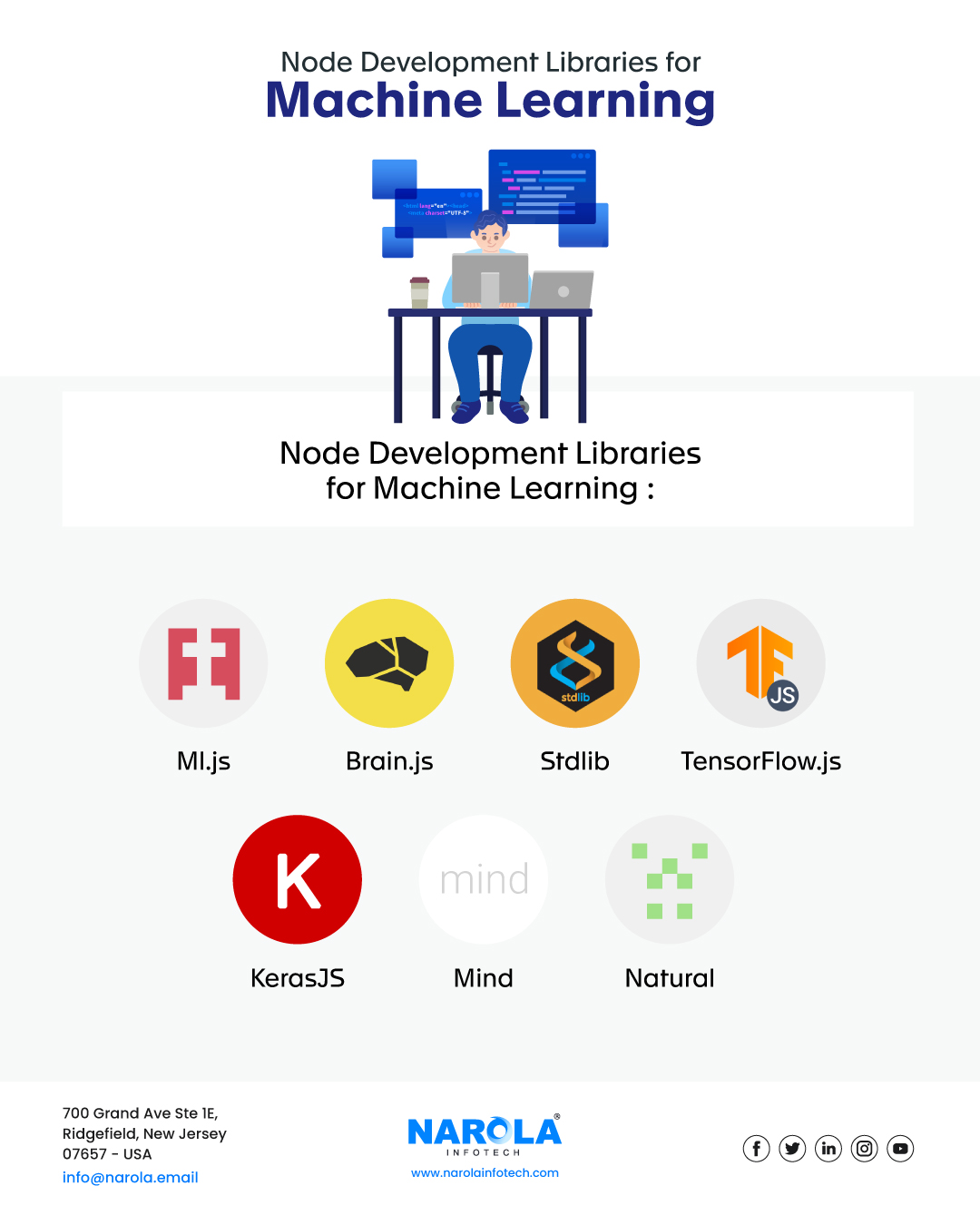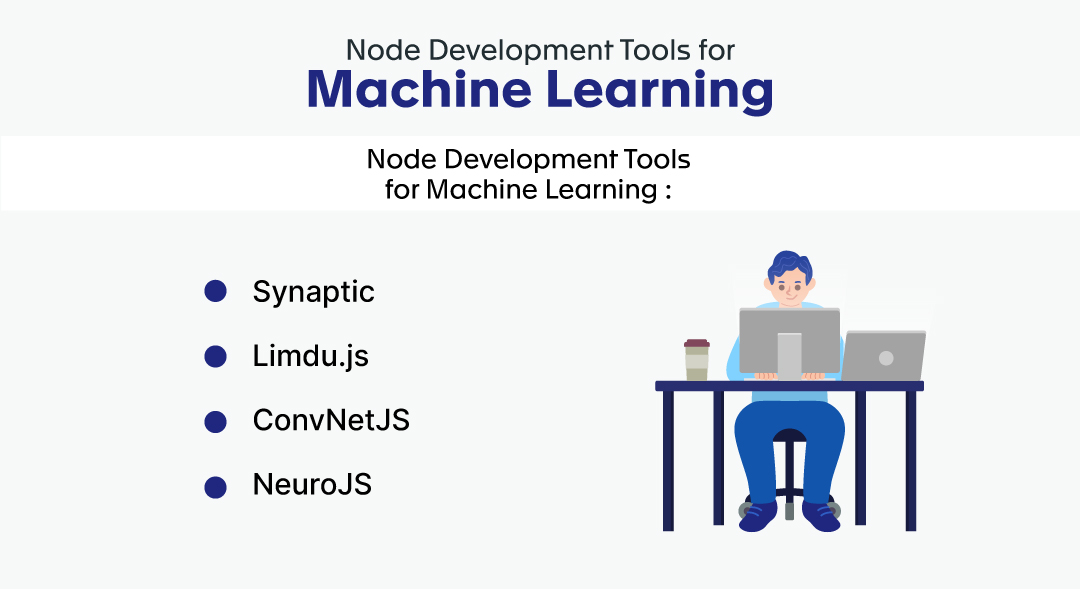Javascript and javascript frameworks such as Node.js are commonly thought of as web programming languages. However, they have a wide range of applications that include desktop applications, mobile applications, embedded devices, and back-end development.
The same is the case with machine learning. If you want to make software using machine learning, you don’t need any other specialists. You can hire Node.js developers for machine learning applications and not just for web programming.
Surprised?
If you are, and if you need a little bit of convincing, then this article is for you. Here, we have discussed different Nodejs application tools and libraries for machine learning.
Ml.js
The ml.js organization has created a variety of utilities that can be found in this library. That’s why it is one of the most important custom Nodejs development services. A few of the topics that it addresses are:
- Unsupervised learning
- Supervised learning
- Artificial neural networks
- Regression
- Optimization
- Statistics
- Data processing
Most of the libraries included in ml.js are designed to be used in a web browser. However, there is a npm package available if developers want to use them in a Node.js environment.
Every tool is available as a distinct part. So, developers don’t have to install them all at once if they don’t want to.
Brain.js
Brain.js is a neural network library developed in the Node.js environment the developers can use in the browser. You can easily access it and begin using it by using npm to install it. As it’s written in JavaScript, it trains network data asynchronously, and it also supports streams.
In general, neural networks are regarded as a math-intensive sub-domain of machine learning. Brain.js can leverage the convenience of JavaScript and limit the API to only a few method calls and settings. By doing that, Brian.js simplifies the process of establishing and training a neural network.
Brain.js is used in a variety of useful machine learning applications. One of them is Cracking Captcha using Neural Networks. Here, the developer utilizes captcha images as the dataset and creates a neural network. It recognizes each individual character using image processing and the Brain.js module.
Stdlib
Stdlib is a JavaScript library that creates advanced statistical and machine learning models in Nodejs app development. It can also be used for data visualization and exploratory data analysis, with plotting and graphics features. There are different libraries that Stdlb supports. That include:
- Linear regression
- Binary classification
- Natural language processing
When it comes to offering tooling assistance, this library is enormous.
TensorFlow.js
TensorFlow is a part of Nodejs web development services for training and deploying machine learning models that is open-source and hardware-accelerated. It is one of the most well-known libraries in the world. The linear algebra library or the high-level layers API can be used to develop models from scratch utilizing flexible and easy-to-use APIs.
TensorFlow has many implementations, and there’s a good explanation for it. Not only is it well-maintained, but it also allows developers to write, train, and deploy GPU-based deep learning models entirely in JavaScript.
It features a large number of tutorials and guidelines provided on its official website. It also includes model converters that allow developers to execute pre-existing TensorFlow models in the browser or with Node.js. That is one of the main reasons why every Node.js development company uses it.
KerasJS
In many aspects, it is comparable to Tensorflow.js. Keras provides support for high-level APIs that handle the abstraction offered by backend frameworks, which is one of the commonalities. Models may be trained in any backend using Keras, and developers can even use Tensorflow to do so.
While using this library directly with a web browser is a common use case, it is not the only one. However, there is one limitation to be aware of when using Keras with Node.js. It is that certain models in custom Node.js development services can only operate in CPU mode.
Mind
It employs matrix implementation to analyze training data and is another adaptable neural network framework for Node.js. It does allow developers to customize the network architecture and use plugins created by the community. These plugins usually allow developers to set up pre-trained networks that can make predictions right away.
Natural
Tokenizing, stemming, categorization, phonetics, tf-idf, WordNet, and string similarity are all features of Natural. To put it another way, this library provides language features that may be used as a module in Nodejs app development. This is a fascinating idea with a wide range of applications.
This library is still in its early stages, and the majority of the algorithms are English-specific. However, the community members have recently added support for languages including Russian and Spanish.
Synaptic
Synaptic is an MIT-developed JavaScript neural network library that may be used with Node.js or in the browser. Due to its architecture-free algorithm and structure, this library has the capacity to design and train any first-order or second-order neural network architecture.
It can also import and export networks to JSON as a standalone function. That will allow them to link to other networks or even gates. It includes
- Multilayer perceptrons
- Multilayer long-short term memory networks (LSTM)
- Liquid state machines or Hopfield networks
Synaptic is also an open-source library, which means that anyone can contribute to it or use it for free. Synaptic also comes with a trainer that can be used to train any neural network using tests. That includes:
- Embedded Reber Grammar test
- An XOR, a Distracted Sequence Recall job
- Built-in training tasks
It also aids in the comparison of different neural network architectures’ performance and can run on any browser.
Limdu.js
Limdu.js is a Node.js machine learning framework that supports binary, multi-label, feature engineering, online learning, and real-time classification. It is currently in alpha, and is searching for contributors who can contribute to this Node.js environment.
Developers might wish to build a classifier on some other computer and then use it on a remote server. To do so, they will need to transform the trained classifier to a string. After that, they will need to transfer it to the remote server, and have it deserialized there.
ConvNetJS
ConvNetJS is a JavaScript library intended primarily for deep learning model training and neural network activity. The most crucial characteristic of this library is that it is completely reliant on browsers. It doesn’t require any other software such as GPUs or compilers. Node.js is also supported by ConvNetJS.
ConvNetJS is made up of standard neural network modules with fully linked layers and nonlinearities. This library allows developers to create and solve neural networks with basic JavaScript. Along with that, it also supports certain popular network modules.
It also supports
- Specifying neural networks
- Classifying and regret problems
- Convolutional networks for image processing
NeuroJS
NeuroJS is a deep learning framework written in JavaScript. It focuses mostly on reinforcement learning, but it may be used for any neural network-based task. It includes several demos to help illustrate these possibilities, such as a 2D self-driving automobile. The capability for deep-q-networks and actor-critic models is also included in this.
In Conclusion
JavaScript isn’t currently a popular programming language for machine learning yet. However, the numerous strong libraries provided here show that it isn’t far behind when it comes to a Node.js app for ML.
The developers of our Nodejs development company understand the importance of machine learning applications. Hence, they use their experience and expertise and leave no stone unturned to create the best app. If you have any queries regarding this, feel free to contact us by filling the form below.


